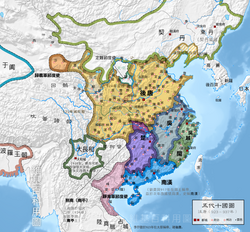Later Tang
This article needs additional citations for verification. (October 2008) |
Tang 唐 | |||||||||||||||||||
|---|---|---|---|---|---|---|---|---|---|---|---|---|---|---|---|---|---|---|---|
| 923–937 | |||||||||||||||||||
 Later Tang 後唐 | |||||||||||||||||||
| Capital | Daming (923) Luoyang (923–936) | ||||||||||||||||||
| Common languages | Chinese | ||||||||||||||||||
| Government | Monarchy | ||||||||||||||||||
| Emperor | |||||||||||||||||||
• 923–926 | Li Cunxu (Zhuangzong) | ||||||||||||||||||
• 926–933 | Li Siyuan (Mingzong) | ||||||||||||||||||
• 933–934 | Li Conghou | ||||||||||||||||||
• 934–936 | Li Congke | ||||||||||||||||||
| Historical era | Five Dynasties and Ten Kingdoms Period | ||||||||||||||||||
• Established in Daming | May 923 | ||||||||||||||||||
• Overthrown by Khitan and Shi Jingtang | January 11, 937 | ||||||||||||||||||
| Currency | Chinese coin, Chinese cash | ||||||||||||||||||
| |||||||||||||||||||
| Today part of | China | ||||||||||||||||||
1.The preceding entity of the Later Tang was the State of Jin, which was established by Li Keyong in 895 under the Tang dynasty and existed as an independent state in 907–923. 2.With the support of the Liao dynasty. | |||||||||||||||||||
Tang, known in historiography as the Later Tang, was a short-lived imperial dynasty that lasted from 923 to 937 during the Five Dynasties and Ten Kingdoms period in the history of China.[1]
The first three of Later Tang's four emperors were ethnically Shatuo.[2] The name Tang was used to legitimize itself as the restorer of the Tang dynasty (618–907). Although Later Tang officially began in 923, the dynasty already existed in the years before, as a polity called Jin (907–923).
At its height, Later Tang controlled most of northern China.
Formation[]
From the fall of the Tang Dynasty in 907, a rivalry had developed between the successor Later Liang, formed by Zhu Wen, and the State of Jin, formed by Li Keyong, in present-day Shanxi. The rivalry survived the death of Li Keyong, whose son Li Cunxu continued to expand Jin territories at the expense of the Later Liang.
Li Keyong forged an alliance with the powerful Khitan, like the Shatuo a people of the northern steppe, a relationship that figured significantly in the expansion and ultimate triumph of the Shatuo. Li Cunxu was successful in overthrowing the Later Liang in 923 and proclaimed himself emperor of the Later Tang, which he referred to as the "Restored Tang". As a part of "restoring the Tang", the capital was moved back to the old Tang eastern seat of Luoyang.
Course[]
The Later Tang was a short-lived regime, lasting only thirteen years. Li Cunxu himself lived only three years after the founding of the dynasty, having been killed during an officer's rebellion in 926. Li Siyuan, the adopted son of Li Keyong, took over the dynasty, but relations with the Khitan had fallen sour. Internal struggles typified the remaining ten years of the dynasty, ending with its toppling in 936 when Shi Jingtang, son-in-law of Li Siyuan and a fellow Shatuo, rebelled, stormed the capital with the help of Khitan troops, and founded the Later Jin.
Extent of Later Tang territories[]
The Later Tang controlled considerably more territory at its height than did the Later Liang. It extended to all the northern territories controlled by the Later Liang as well as its own base in Shanxi. It also had control over the areas around Beijing and Shaanxi, which were not entirely under the control of the Later Liang. The largest expansion of the Later Tang occurred in 925 when they conquered the Former Shu State, centered in present-day Sichuan. However, as Later Tang power was waning, a Later Shu state formed in 934, two years before the fall of the Later Tang.
Rulers[]
| Temple names | Posthumous names | Family names and given name | Chinese naming conventions | Durations of reigns | Era names and their according durations |
|---|---|---|---|---|---|
| Zhuāngzōng (莊宗) | Lǐ Cúnxù (李存勗) | Family name and given name | 923–926 | Tóngguāng (同光) 923–926 | |
| Míngzōng (明宗) | Lǐ Sìyuán (李嗣源) or Lǐ Dǎn (李亶) | Family name and given name | 926–933 | Tiānchéng (天成) 926–930 Chángxīng (長興) 930–933 | |
| none | Mǐn (閔) | Lǐ Cónghòu (李從厚) | Family name and given name | 933–934 | Yìngshùn (應順) 933–934 |
| none | Mòdì (末帝) | Lǐ Cóngkē (李從珂) | Family name and given name | 934–937 | Qīngtaì (清泰) 934–937 |
Later Tang rulers family tree[]
| Rulers family tree | |||||||||||||||||||||||||||||||||||||||||||||||||||||||||||||||||||||||||||||||||||||||||||||||||||||||||||||||||||||||||||||||||||||||||||||||||||||||||||||||||||||||||||||||||||||||||||||||||||||||||||||||||||||||||||||||||||||||||||||||||||||||||||||||||||||||||||||||||||||||||||||||||||||||||||||||||||||||||||||||||||||||||||||||||||||||||||||||||||||||||||||||||||||||||||||||||||||||||||||||||||||||||||||||||||||||||||||||||||||||||||||||||||||||||||||||||||||||||||||||||||||||||||||||||||||||||||||||||||||||||||||||||||||||||||
|---|---|---|---|---|---|---|---|---|---|---|---|---|---|---|---|---|---|---|---|---|---|---|---|---|---|---|---|---|---|---|---|---|---|---|---|---|---|---|---|---|---|---|---|---|---|---|---|---|---|---|---|---|---|---|---|---|---|---|---|---|---|---|---|---|---|---|---|---|---|---|---|---|---|---|---|---|---|---|---|---|---|---|---|---|---|---|---|---|---|---|---|---|---|---|---|---|---|---|---|---|---|---|---|---|---|---|---|---|---|---|---|---|---|---|---|---|---|---|---|---|---|---|---|---|---|---|---|---|---|---|---|---|---|---|---|---|---|---|---|---|---|---|---|---|---|---|---|---|---|---|---|---|---|---|---|---|---|---|---|---|---|---|---|---|---|---|---|---|---|---|---|---|---|---|---|---|---|---|---|---|---|---|---|---|---|---|---|---|---|---|---|---|---|---|---|---|---|---|---|---|---|---|---|---|---|---|---|---|---|---|---|---|---|---|---|---|---|---|---|---|---|---|---|---|---|---|---|---|---|---|---|---|---|---|---|---|---|---|---|---|---|---|---|---|---|---|---|---|---|---|---|---|---|---|---|---|---|---|---|---|---|---|---|---|---|---|---|---|---|---|---|---|---|---|---|---|---|---|---|---|---|---|---|---|---|---|---|---|---|---|---|---|---|---|---|---|---|---|---|---|---|---|---|---|---|---|---|---|---|---|---|---|---|---|---|---|---|---|---|---|---|---|---|---|---|---|---|---|---|---|---|---|---|---|---|---|---|---|---|---|---|---|---|---|---|---|---|---|---|---|---|---|---|---|---|---|---|---|---|---|---|---|---|---|---|---|---|---|---|---|---|---|---|---|---|---|---|---|---|---|---|---|---|---|---|---|---|---|---|---|---|---|---|---|---|---|---|---|---|---|---|---|---|---|---|---|---|---|---|---|---|---|---|---|---|---|---|---|---|---|---|---|---|---|---|---|---|---|---|---|---|---|---|---|---|---|---|---|---|---|---|---|---|---|---|---|---|---|---|---|---|---|---|---|---|---|---|---|---|---|---|---|---|---|---|---|---|---|---|---|---|---|---|---|---|---|---|---|---|---|---|---|---|---|---|---|---|---|---|---|---|---|---|---|---|---|---|---|---|---|---|---|---|---|---|---|---|---|---|---|---|---|---|---|---|---|---|---|---|---|---|---|---|---|---|---|---|---|---|---|---|---|---|---|---|---|---|---|---|
| |||||||||||||||||||||||||||||||||||||||||||||||||||||||||||||||||||||||||||||||||||||||||||||||||||||||||||||||||||||||||||||||||||||||||||||||||||||||||||||||||||||||||||||||||||||||||||||||||||||||||||||||||||||||||||||||||||||||||||||||||||||||||||||||||||||||||||||||||||||||||||||||||||||||||||||||||||||||||||||||||||||||||||||||||||||||||||||||||||||||||||||||||||||||||||||||||||||||||||||||||||||||||||||||||||||||||||||||||||||||||||||||||||||||||||||||||||||||||||||||||||||||||||||||||||||||||||||||||||||||||||||||||||||||||||
References[]
Citations[]
Sources[]
- Mote, F. W. (1999). Imperial China: 900-1800. Harvard University Press.
- Later Tang
- Five Dynasties and Ten Kingdoms
- Dynasties in Chinese history
- Former countries in Chinese history
- 923 establishments
- 10th-century establishments in China
- 936 disestablishments
- 10th-century disestablishments in China
- States and territories established in the 920s
- States and territories disestablished in the 930s